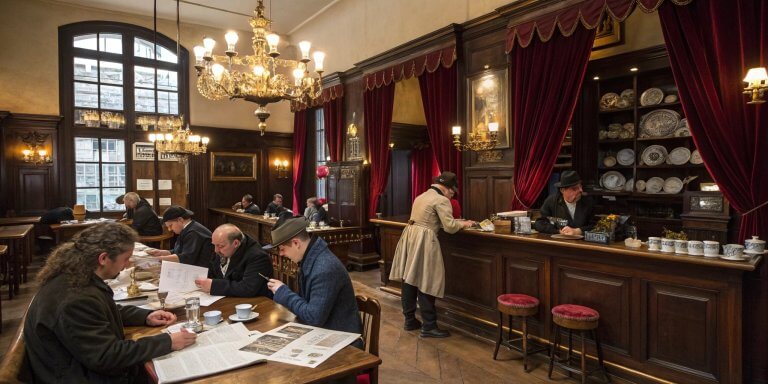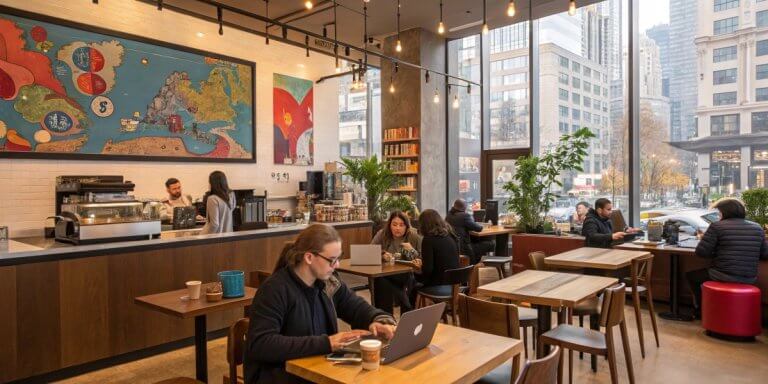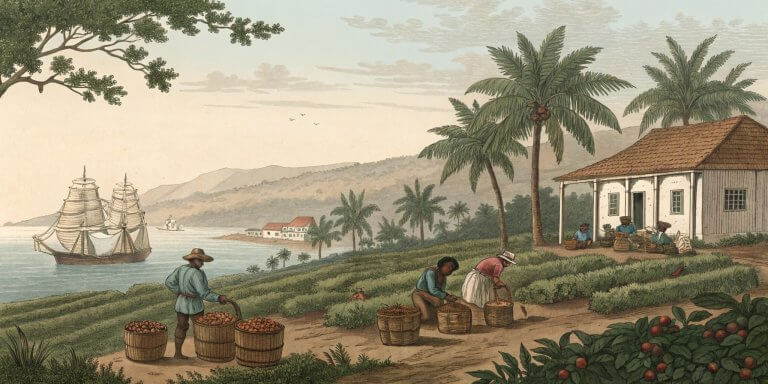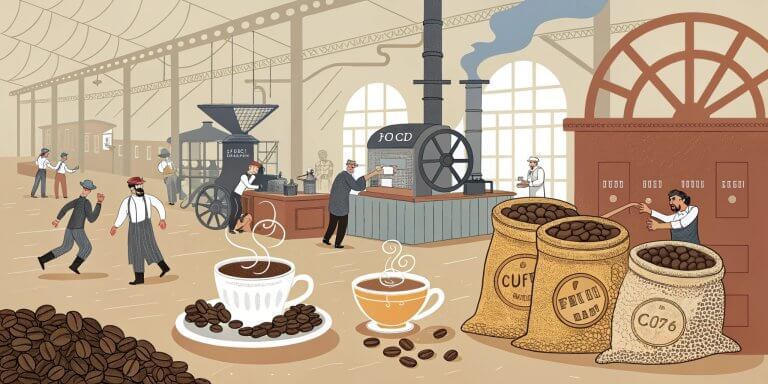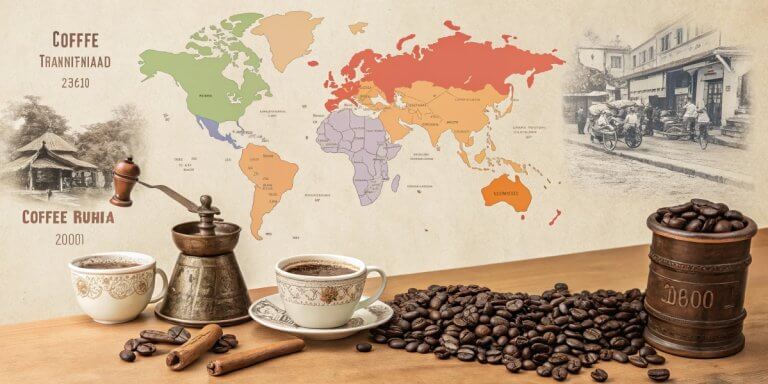
Coffee is such a familiar part of our everyday lives that it’s hard to imagine when this rich, aromatic drink was virtually unknown in Europe. But, as with many plentiful global commodities, coffee’s journey from an exotic bean to a European staple is a fascinating tale of trade, culture, and transformation. The rise of coffee in Europe tells a story of a refreshing drink and a beverage that changed how people socialized, worked, and even thought. Let’s explore how coffee conquered Europe , once an unfamiliar drink from the Middle East, became one of Europe’s most beloved beverages.
Coffee’s Early Beginnings: Arrival in the Middle East and Europe
Coffee’s journey to Europe began in Ethiopia, where it was first discovered. Legend has it that a goat herder named Kaldi noticed his goats becoming unusually energetic after eating berries from a particular plant. Curious, Kaldi tried them himself and soon realized their energizing effects. From Ethiopia, coffee spread to Yemen, where it became a cultivated crop by the 15th century
Yemen’s port city of Mocha became the hub of the coffee trade, and the drink quickly spread across the Middle East. By the early 1600s, Venetian traders—who had close ties with the Ottoman Empire—brought coffee to Europe. Initially, the drink was considered exotic and enjoyed mainly by the wealthy.
European Fascination: First Encounters and Resistance
When coffee arrived in Europe, it was met with both curiosity and resistance. Some Europeans were hesitant to try the drink due to its association with the Islamic world. Coffee was even dubbed the ‘devil’s drink’ because of its stimulating effects. This skepticism was particularly strong in Italy, where some Christian authorities even considered banning it. However, coffee’s resilience and the changing tide of opinion led to its acceptance in Christian Europe, marking the beginning of its journey to becoming a beloved European beverage.
However, the situation changed when Pope Clement VIII was offered coffee. According to legend, he tasted it and declared it too delicious to be left to the “infidels” alone. His approval led to the broader acceptance of coffee in Christian Europe, and soon, the drink began to spread across the continent.
The Coffeehouse Phenomenon: Social and Intellectual Hubs
Once coffee was accepted in Europe, it took a little while for coffeehouses to start popping up in major cities. The first coffeehouse in Europe opened in Venice in 1645, and soon, coffeehouses could be found in London, Paris, and Vienna.
These establishments weren’t just places to drink coffee—they became centers of social interaction, intellectual exchange, and business.
In London, coffeehouses were often called “penny universities” because one could engage in lively discussions on politics, science, and philosophy for the price of a cup of coffee. Many coffeehouses even became the birthplace of essential institutions. For example, Lloyd’s Coffee House eventually evolved into Lloyd’s of London, one of the world’s leading insurance markets.
In Paris, Enlightenment thinkers like Voltaire and Rousseau frequented coffeehouses, where they discussed ideas about liberty, reason, and the role of government. This intellectual culture helped spark revolutionary ideas that shaped Europe’s future.
Coffee’s Expansion Through European Colonies
As coffee became more popular in Europe, demand for the beverage soared. European colonial powers, eager to control coffee production, began cultivating it in their overseas territories. The Dutch were the first to establish coffee plantations in Java (modern-day Indonesia) in the late 1600s. This was followed by the French, who introduced coffee to the Caribbean islands of Haiti and Martinique.
In the 18th century, coffee plants were brought to Brazil, where the climate and soil proved ideal for cultivation. By the 19th century, Brazil had become the world’s largest coffee producer—a title it still holds today.
This expansion of coffee production helped ensure a steady supply of beans to meet Europe’s growing demand.
Coffee’s Role in Shaping European Society
Coffee didn’t just change what people drank; it changed how they interacted. Before coffee spread, many Europeans started their day with beer or wine, often feeling sluggish. But coffee’s stimulating properties made it an ideal beverage for morning consumption. People who drank coffee instead of alcohol found themselves more alert, improving their productivity and work quality.
Coffeehouses played a pivotal role in the development of the public sphere. They were not just places to drink coffee, but also intellectual hubs where people from different social classes could gather to discuss ideas, read the latest news, and engage in debates. This made coffeehouses vital to the cultural and political life of Europe during the Enlightenment and beyond, stimulating intellectual exchange and shaping European society.
The Cultural Impact of Coffee in Europe
Coffee became a symbol of sophistication and intellectualism in Europe. It was served in elegant cafés in France, where writers, artists, and philosophers gathered to exchange ideas. In Vienna, coffeehouses became a central part of the city’s cultural life, and the tradition of lingering over a cup of coffee while reading or talking with friends is still an essential part of Viennese culture today.
In Italy, espresso bars became a staple of daily life, and Italians developed their own unique coffee culture. Espresso was enjoyed quickly while standing at the bar. Each country in Europe developed its own way of enjoying coffee, but the common thread was that coffee had become much more than just a drink—it was a cultural experience.
The Industrial Revolution and Coffee’s Popularity
The Industrial Revolution of the 19th century brought significant changes to coffee production and consumption. New brewing methods, such as the invention of the espresso machine in Italy, allowed for faster and more efficient coffee preparation. Instant coffee, developed in the early 20th century, made coffee even more accessible to the masses.
As coffee became more widely available, it cemented its place as a daily necessity for millions across Europe. During World War II, instant coffee became a staple for soldiers, and its popularity grew after the war ended. Today, coffee is enjoyed in countless forms, from espresso and cappuccino to lattes and cold brew.
The Legacy of Coffee in Europe Today
Today, coffee remains an essential part of European culture. In cities like Paris, Rome, and Vienna, coffeehouses continue to be gathering places for social interaction and intellectual exchange. Modern trends like specialty coffee, which focuses on high-quality beans and artisanal brewing methods, continue Europe’s long tradition of coffee appreciation.
In addition to its cultural significance, the coffee industry is also focused on sustainability and ethical sourcing. Many consumers now seek fair trade coffee to ensure that farmers are paid fairly and that environmentally friendly practices are used in coffee production.
Conclusion
From its humble beginnings as an exotic bean in the Middle East to its status as a European staple, coffee’s journey is a remarkable story of trade, culture, and transformation. It’s a beverage that has shaped how we start our day and played a crucial role in shaping Europe’s intellectual and social life. Today, as we sip our morning coffee, we are participating in a tradition that spans centuries and has left an indelible mark on European society and culture.

